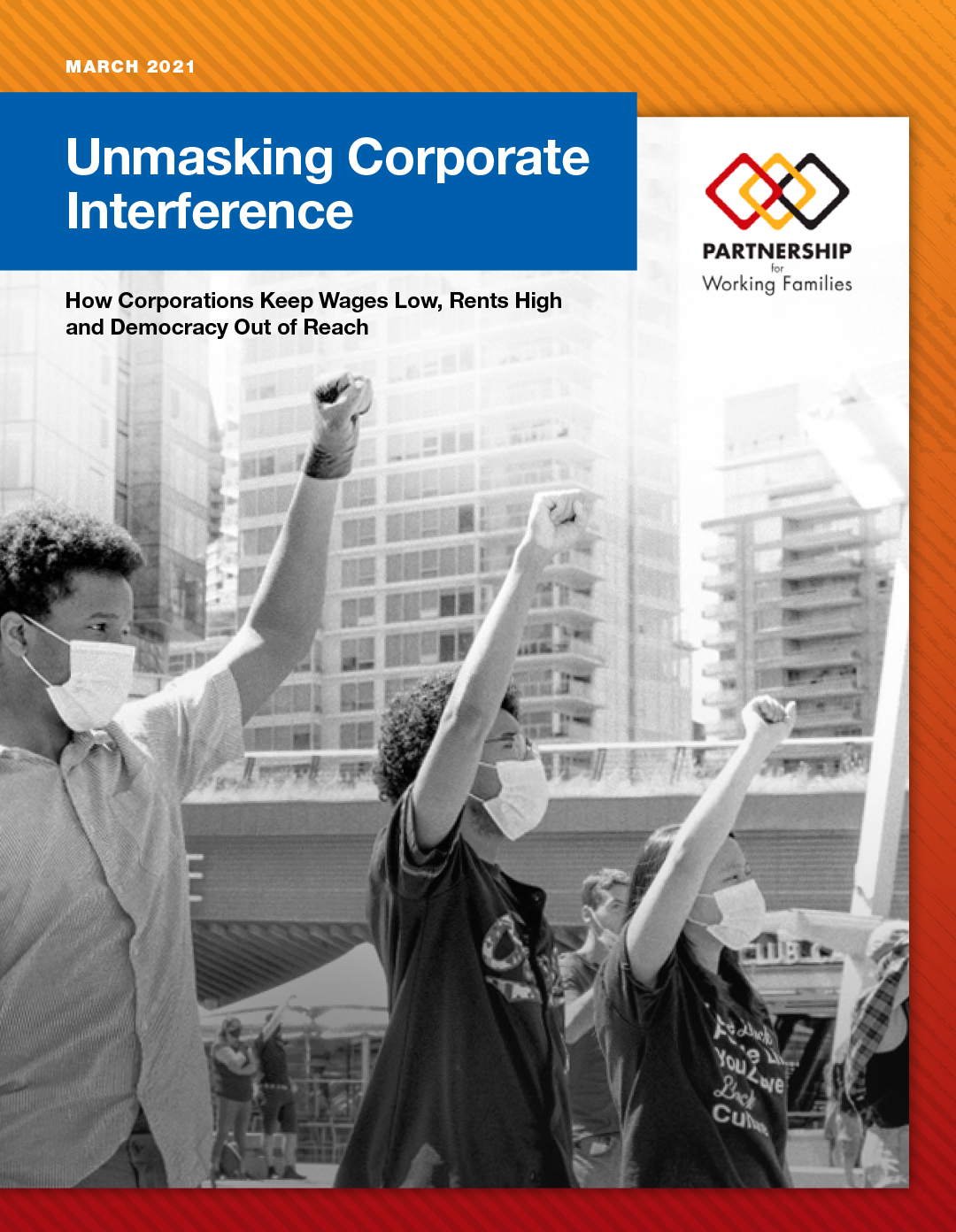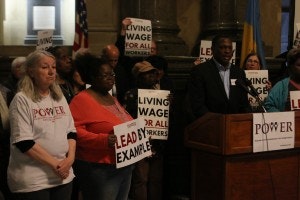Everywhere you look these days, community benefits is taking root. What started as a simple effort in a few communities to rethink how real estate development contributed to poverty and inequality has grown into a full-fledged movement that is reshaping how community leaders think about economic, environmental and racial justice.
It’s a testament to our network, where these innovations were first pioneered.
Just over 10 years ago, LAANE and its allies in Los Angeles negotiated the nation’s first Community Benefits Agreement (CBA). The Staples Center CBA made national headlines and became a model for cities across the country. Its appeal? A simple and nearly undeniable premise: if taxpayer money subsidizes development all communities should see clear benefits.
The message has been as powerful as the campaign and policy tools.
The model caught fire, with 16 organizations officially affiliated with the Partnership network, and leaders in at least ten other cities looking to our example to guide their vision. The tools for achieving more accountable development expanded from CBAs to include comprehensive local policies that set standards for job quality, job access, affordable housing, and green construction. Construction careers policies developed that connect union jobs and local hiring.
This year proved the community benefits movement has never been stronger. The Partnership network continues to seek innovations. Our affiliates are consolidating past wins, applying community benefits principles to major new and catalytic redevelopments, and identifying new areas of their local economies that are ripe for reconfiguration. (Read more about EBASE’s successful five year effort to win community benefits for the Oakland Army Base redevelopment)
Meanwhile, in communities across the country, community organizations, labor union leaders and policy makers are growing the community benefits movement. Portland, OR passed a community benefits policy. The Housing Authority of New Orleans agreed to negotiate community workforce agreements – including strong targeted hire provisions – for a series of upcoming construction projects. Similarly, Santa Fe, NM, established a requirement to negotiate community workforce agreements for publicly-funded construction.
Those campaigns came to fruition this year, and many more are underway. Coalitions in Allentown and Philadelphia, PA; Tampa and St. Petersburg, FL; Detroit, MI; and Gulfport, LA are all working to establish community benefits principles in public policy. Mayor Jackson, of Cleveland, OH, sponsored a community benefits forum in August. The success of that event – including the mayor’s pledge to identify a community benefits agenda for Cleveland – has spawned new requests for the Partnership’s national staff to help stage the public conversation necessary to make community benefits a reality in other cities.
Professor Janet Hammer, of Portland State University, spearheaded an effort to create a triple bottom line measurement tool. This tool, developed with federal funding, evaluates the triple bottom line – or what we might call the community benefits – of a proposed redevelopment project, providing grant makers, financiers, developers, public officials, and community leaders with a new way of assessing the real impact of a proposed project.
Our body of work is the touchstone for this movement. Our research documents the impact of success. Our policy development includes a range of approaches that can work in a variety of contexts. Our team of leaders has learned how to move a proposal to policy. Our organizers have shined a light on the powerful potential of strong coalitions and grassroots leadership.
It’s exciting to observe this movement growing in capacity and relevance. Real movement success means that more and more community benefits campaigns will emerge, some of them fueled by our technical assistance, others learning from our example but evolving independently from us. As we continue to deepen our tools and expertise, we are both challenged and inspired by the broader effort, and we look forward to working with more coalitions, more leaders, in more communities in 2013.
*****************
Learn more about CBAs in 2012
East Coast
In Allentown, PA members of Congregations United for Neighborhood Action (CUNA) called on the city to allow more seats at the table in the planning of the downtown arena. Now the group has joined with local churches and community groups to create the Allentown Community Benefits Coalition. They are engaging downtown residents to develop a list of ways a new publicly funded hockey arena should benefit surrounding neighborhoods.
POWER, a congregation based organization in Philadelphia, sees the proposed $6.4 billion expansion of the airport as a once in a lifetime public/private project that can provide thousands of construction and permanent jobs to local residents. They have joined with UNITE HERE and SEIU 32 BJ to form “Fight for Philly.”
As Philadelphia Councilman Kenyatta Johnson, chairman of the City’s Transportation Committee puts it, "We're looking to make this a first-class airport. I think the expansion is a great opportunity to provide quality jobs and living wages that enable Philadelphians to support their families."
Casa de Maryland in suburban Washington, DC was founded in 1985 in response to the human needs of the thousands of Central Americans arriving to the D.C. area after fleeing wars and civil strife in their countries of origin. They have centers throughout the region, focusing on workers’ and tenants’ rights. The new Purple mass transit line will cut through many of the low income communities they have worked in for decades. They realized that this major infrastructure investment should strengthen their neighborhoods, not destroy them.
They have developed a platform of housing, small business development, access to health care and jobs. Hundreds of community residents have already been mobilized to support those demands.
South
Faith and Action for Strength Together (FAST), an interfaith social justice group made up of 38 houses of worship in Pinellas County, has been moving a local hire ordinance through the St. Petersburg, FL city council. The law will help disadvantaged and minority residents land jobs on projects like the new $40 million police headquarters and the $50 million Pier project, known as the Lens.
The expansion of the Port of Gulfport, MS is being done with a diversion of over $500 million of Katrina recovery money. The Steps Coalition is working to ensure the money diverted to the port is responsibly spent. They are working to ensure jobs go to low and moderate income local workers, there is a healthy work environment at the port and that job training is provided for the jobs that become available.
In nearby New Orleans, the New Orleans Workers’ Center for Racial Justice and the local building trades are organizing for local hiring and Project Labor Agreements for post-Katrina reconstruction by the Housing Authority of New Orleans (HANO).
Under pressure from residents, HANO administrators have audited employment at the site, even allowing resident monitors into housing authority offices. The newest HANO numbers show progress: 52 percent of new hires at Cooper -- 24 of 46 workers -- are people whose low incomes have been verified.
Midwest
For five years, the Southwest Detroit Community Benefits Coalition has been organizing for a CBA for a proposed bridge to Canada. In mid-June Michigan and Canada signed an agreement that stipulates "community benefits" will be necessary criteria in the bridge Request for Proposals. The Building Trades Council and the coalition have developed a unified agreement on a jobs proposal for the project.
In the November elections, Michigan voters defeated Proposal 6, which would have called for a statewide vote on plans for any new international crossing. Proposal 6 was one of the final hurdles that needed to be cleared for the building of a new bridge to proceed, and provide competition for the 83-year-old Ambassador Bridge, Canada's busiest border crossing, owned by billionaire Matty Moroun.
Cleveland, Ohio was the site of a dramatic conversation between community, labor, business and union leaders convened by Mayor Frank Jackson’s office to discuss a shared community benefits agenda for a wave of anticipated development in the city. The Mayor and the head of the building trades unions in Cleveland, Loree Soggs, both publicly pledged that they would work to advance a community benefits agenda for development in the city.
West
Portland, OR is about to try out a new kind of project labor agreement on public construction contracts. On all future City construction projects over $15 million, unions will represent workers, and women and minority workers and contractors will have expanded opportunities. The community benefits agreement was developed in nearly two years of meetings among unions, minority contractors, pre-apprenticeship training programs, and city officials.
In Santa Fe, Mayor David Coss played a big role in getting the city council to approve a Community Workforce Agreement (CWA) for all public construction. While some contractors are attempting to block the policy, Peter Brill, president of Sarcon Construction Corporation, says he hires his employees solely through construction unions because their members learn proper skills and safety through sponsored apprenticeships. The CWA, he says, would encourage more of this in Santa Fe. “A trained and skilled workforce is critical,” Brill says. “If the CWA achieves that goal, we’re all for it.”





